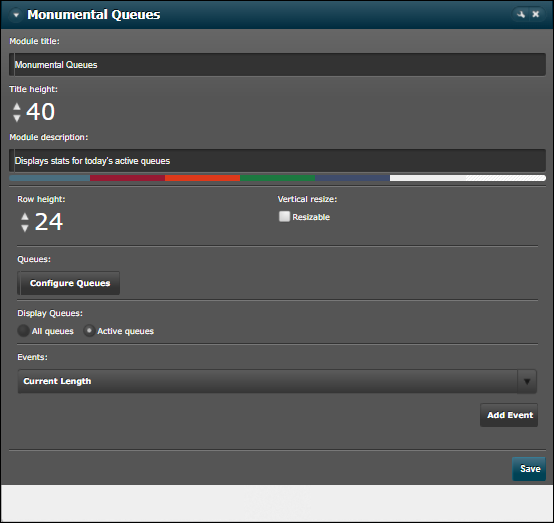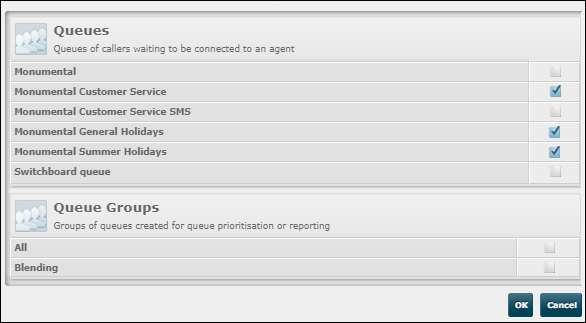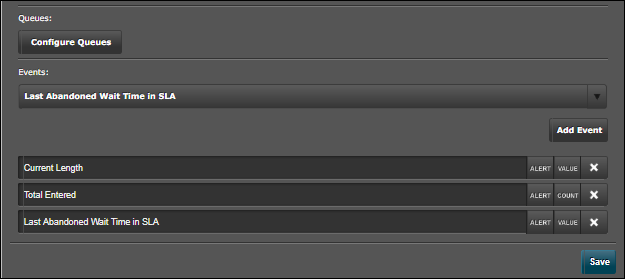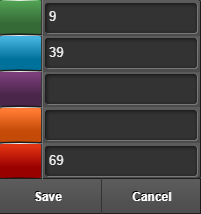Configure a Real-Time Queues Module
This is a procedural topic for administrators describing how to configure a real-time Queues Module.
This topic also covers the following related tasks:
Change an Event's Measurement Type
Configure an Event's Value to Change Colour on Reaching Chosen Thresholds
Enable the Module to be Resized Manually
Prerequisites
- You have logged in to storm with your user log in credentials and then launched the VIEW application. See Log in to storm and Launch VIEW.
- You are familiar with the VIEW Dashboard Interface.
- You have created a real-time dashboard. See Create a Dashboard for Real-Time Statistics.
- You know how to place real-time modules from the Module palette. See Place Real-Time Modules on a Dashboard.
- You are familiar with the meanings of the real-time statistics supported in the module. See Queues Module.
Basic Configuration
-
From the Module palette, drag and drop a Queues module onto an empty part of the dashboard.

-
Click the
 button in the module's title bar to display the configuration options.
button in the module's title bar to display the configuration options. -
Enter a meaningful name and description for the module. The description will appear in a tooltip when a mouse cursor hovers over the module's title bar.

-
If desired, change the height and colour of the module's title bar using the title height control and by clicking a colour on the colour bar.
-
Click Configure Queues and then select the check boxes for the queues and queue groups whose statistics you want to display. Then click OK.

-
In the Display Queues section, select one of the following two options:
|
Option |
Meaning |
|
All Queues |
The module will show statistics for all queues. |
|
Active Queues |
The module will show statistics for queues that have received entrants since statistics were last reset (typically just after midnight). This allows supervisors to focus their attention on queues that have been active today. |
-
From the Events options list, select a statistic (event) you wish to display for each queue and then click Add Event. Repeat this for other statistics and then click Save. See Queues Module for a description of each available event.

Each selected event is represented by a column in the module:

Related Tasks
|
Task |
Procedure |
||||||||||||
|
Click Configure Queue in the configuration panel and then clear the check box for the queue you want to remove. |
|||||||||||||
|
Click the |
|||||||||||||
|
Edit the event name directly in the configuration panel and then click Save.
|
|||||||||||||
|
In the configuration panel, click the button to the left of
Note: if you select another type, ensure that you edit the name of the event to reflect the new behaviour. For example, if you change the 'Current Length' event to 'Maximum Value', you might edit its name to read 'Maximum Value'. Changing an event's name is described in Change a Column Name, above. |
|||||||||||||
|
Configure an Event's Value to Change Colour on Reaching Chosen Thresholds |
Click Alert. Type threshold value limits next to some or all of the colours, which when exceeded will display the value in those colours. For example, with the settings shown, a value will display in green at 10, in blue at 40, and in red at 70. |
||||||||||||
|
Select the Resizable check box and then click Save. You can resize the module by clicking and dragging its bottom edge. |
Equivalent Historical Statistics
Use this section if you wish to present historical statistics that are close or equivalent to the real-time statistics supported in the Queues module.
In the following tables, the Statistic column is the statistic name as seen in the Queues module. The second column displays the equivalent historical statistic and, where relevant, the standard historical report where the statistic is available.
For detailed descriptions of these historical statistics, see the storm VIEW Standard Historical Reports Reference Guide or the storm VIEW Historical Data Source Reference Guide.
|
Name |
Equivalent standard historical statistic |
|
Queued Call Count (voice only) |
|
|
Queued Calls Connected (voice only) |
|
|
Queued Calls Connected Inside SLA (voice only and 30-second service level) |
|
|
Calls Lost in Queue (voice only) |
|
|
Calls Lost in Queue (5-30s) (voice only and 30-second service level) |
|
|
% SLA (voice only) |
|
|
% Answer Rate (Connected/Offered) % Routed rate (voice only)* |
|
|
% Lost Rate (voice only)* |
*Also available in the standard historical Voice Queues. See the document storm VIEW Standard Historical Reports Reference Guide.
Explore Further
 button in the configuration panel.
button in the configuration panel.

